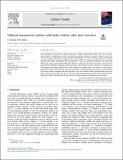Files in this item
Ordered mesoporous carbons with body centred cubic pore structure
Item metadata
| dc.contributor.author | Sakina, F. | |
| dc.contributor.author | Baker, R.T. | |
| dc.date.accessioned | 2021-04-27T12:30:22Z | |
| dc.date.available | 2021-04-27T12:30:22Z | |
| dc.date.issued | 2021-07 | |
| dc.identifier | 273968734 | |
| dc.identifier | 6c8ca8dc-7066-4c90-b2dc-8680342ec294 | |
| dc.identifier | 85115027339 | |
| dc.identifier.citation | Sakina , F & Baker , R T 2021 , ' Ordered mesoporous carbons with body centred cubic pore structure ' , Carbon Trends , vol. 4 , 100051 . https://doi.org/10.1016/j.cartre.2021.100051 | en |
| dc.identifier.issn | 2667-0569 | |
| dc.identifier.other | RIS: urn:02601D3F176F4C8257A02C28EEA9074B | |
| dc.identifier.other | ORCID: /0000-0002-3304-3280/work/93161395 | |
| dc.identifier.uri | https://hdl.handle.net/10023/23093 | |
| dc.description | The authors thank the University of St Andrews for a PhD scholarship for FS. Raman Spectroscopy was performed at the Light Element Analysis Facility (EPSRC grant EP/T019298/1), University of St Andrews, and we acknowledge EPSRC Strategic Resources Grant (EP/R023751/1). | en |
| dc.description.abstract | The preparation of mesoporous carbons possessing a highly ordered body centred cubic (bcc) arrangement of pores by employing a halide- and metal-free synthesis method is reported. Products were characterised using gas physisorption, Small Angle X-ray Diffraction and X-ray Scattering, Raman spectroscopy and High Resolution Transmission Electron Microscopy (TEM). The materials produced in this work had Specific Surface Areas of between 422 and 988 m2g−1 and pore diameters of around 7 nm. From the TEM images, high quality Digital Diffraction Patterns, relating to the ordered mesopore structure, were obtained. On increasing calcination temperature from 350 to 1000°C the bcc structure was retained but its dimensions decreased progressively as the mesopore structure shrank. The effects on the structure and texture of the materials of the three key parameters of polymerisation time and the concentrations of the two catalysts employed, NH4OH and oxalic acid, were studied. Shorter polymerisation times and lower catalyst concentrations gave rise to the most well-ordered products whereas longer polymerisation times with higher concentrations of base and acid catalyst resulted in disordered pore structures. | |
| dc.format.extent | 12 | |
| dc.format.extent | 6442543 | |
| dc.language.iso | eng | |
| dc.relation.ispartof | Carbon Trends | en |
| dc.subject | Porous materials | en |
| dc.subject | Transmission Electron Microscopy | en |
| dc.subject | Gas physisorption | en |
| dc.subject | Resol | en |
| dc.subject | Cubic | en |
| dc.subject | Carbon | en |
| dc.subject | QD Chemistry | en |
| dc.subject | NDAS | en |
| dc.subject.lcc | QD | en |
| dc.title | Ordered mesoporous carbons with body centred cubic pore structure | en |
| dc.type | Journal article | en |
| dc.contributor.sponsor | EPSRC | en |
| dc.contributor.sponsor | EPSRC | en |
| dc.contributor.institution | University of St Andrews. School of Chemistry | en |
| dc.contributor.institution | University of St Andrews. St Andrews Sustainability Institute | en |
| dc.contributor.institution | University of St Andrews. EaSTCHEM | en |
| dc.identifier.doi | 10.1016/j.cartre.2021.100051 | |
| dc.description.status | Peer reviewed | en |
| dc.identifier.url | https://www.sciencedirect.com/science/article/pii/S2667056921000286?via%3Dihub#sec0017 | en |
| dc.identifier.grantnumber | EP/T019298/1 | en |
| dc.identifier.grantnumber | EP/R023751/1 | en |
This item appears in the following Collection(s)
Items in the St Andrews Research Repository are protected by copyright, with all rights reserved, unless otherwise indicated.

